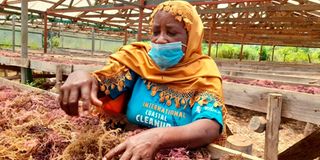This is how we can address the gender question in cooperatives

Fatuma Mohammed, seaweed farmer and the chairperson of Kibuyuni Seaweed Farmer's Cooperative spreads out harvested seas weeds in Kwale County.
The 2019 census recorded a men-to-women ratio of 49.5:50.5 among the population of 47.6 million. But that is reflected in other statistical indicators. Despite Kenya ranking top in cooperatives in Africa and seventh globally, the ratio of women to men in key areas like agriculture is dismal. “KNBS Statistical Abstracts 2020” says there are over 21,000 cooperatives (6,347 of them agricultural) with women 10 per cent (northeastern region) and 40 per cent (Nairobi) of the 14 million members.
A nationwide survey commissioned by State Department of Cooperatives last year recorded 57 per cent of women staff and 28 per cent management.
Women’s participation in cooperatives is curtailed by household gender-power relations, cultural forces, unequal access to educational opportunities and legal/policy bottlenecks. For instance, household gender-power inequity pushes women to the periphery in decision-making. Women play a bigger role in agricultural production (contributing up to 80 per cent of food), yet the financial benefits often go to the men.
Women’s ownership of land (they own less than one per cent of the land) is constrained by lingering cultural factors dictating who can inherit land and, consequently, join agricultural cooperatives. Furthermore, the legal/policy frameworks tend to be gender-blind.
That constrains women’s access to finance. They receive under 10 per cent of credit to small-scale farmers. In Kenya, only three per cent of women (compared to 44 per cent men) have access to formal financial services. They are pushed to (often informal) smaller groups, chamas, which are weakly connected to funding and training opportunities.
Above-average incomes
However, belonging to a cooperative has a positive impact on women’s lives. A recent multi-country study by US Overseas Cooperative Development Council in Kenya, Poland, the Philippines and Peru, “What Difference Do Cooperatives Make?”, revealed that cooperatives make a measurable difference in members’ lives and women, particularly, have greater potential in enhancing them.
Five important points emerge. First, cooperative members reported higher incomes than the average Kenyan. They were more likely to have average and above-average incomes than non-members and less likely to be poor or very poor. Their incomes, benchmarked against national statistics, are higher.
Secondly, members attributed their higher annual income and relative economic well-being to their cooperative membership, which positively affects households’ financial situation. This, for the majority, happens through “access to loans, savings, shares and commissions” from their cooperatives’ support leading to diversification and resilience.
Thirdly, while women are demographically under-represented, they nearly unanimously believed cooperative membership positively influences their economic well-being. They reported higher earnings than their female non-member counterparts. They reported improved access to loans, markets and higher-quality education for their children.
Fourth, cooperatives were seen as positive players in the local economy: They can attract investors, create jobs and provide support during emergencies. Cooperatives are most valued for their financial services.
Social benefits
Finally, they provide significant social benefits. Many cooperative members reported use of increased income to pay for school fees and uniforms for their children, thus increasing their communities’ literacy levels and families’ earning potential. Members benefitted from training in financial management and discipline, encouraging healthy saving habits and prudent financial planning.
To make cooperatives more gender-responsive, changes are needed at two levels.
First, at the micro level, secure men’s unqualified support for women’s ventures to enable them to participate effectively in the cooperative activities. Membership should recognise the lopsided farm-level time investments by women. Further, there is a need to replicate and scale up good practices that incorporate and recognise women’s contribution and provide targeted skills development for women cooperative members.
Secondly, at the macro level, there is a need for actions to support counties to develop appropriate gender-sensitive laws/policies supporting cooperative operations and functions. That should benefit everyone and help even out documented gender differences.
[email protected]. @Prof_IKNyamongo





